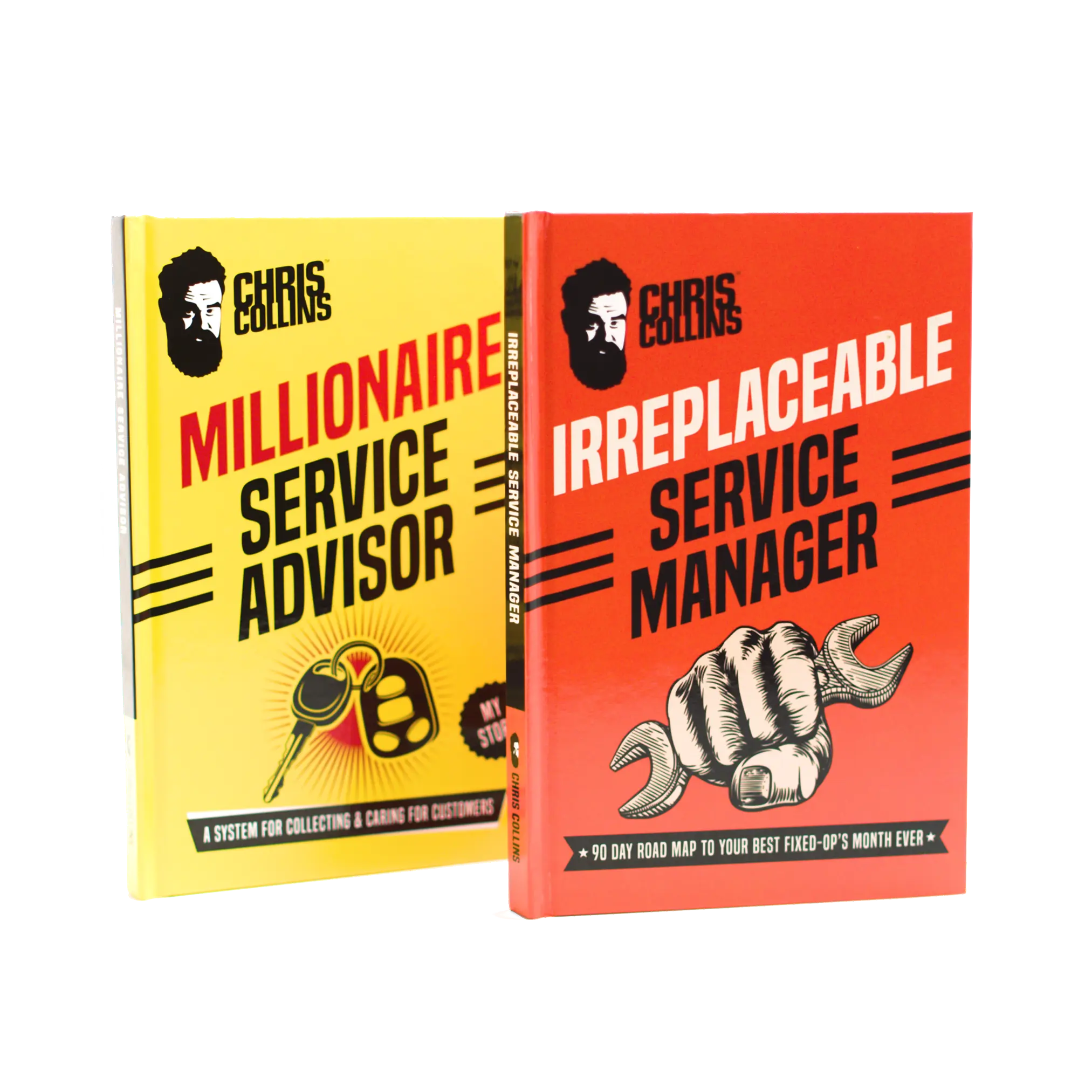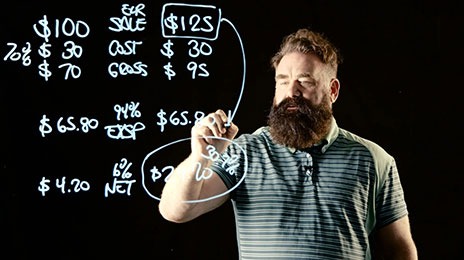
HERE’S WHAT YOU NEED TO KNOW ABOUT FIXED OPS CONSULTANTS
Operating your business for more than ten years will definitely require Fixed Operations Consultant (also Fixed Ops Consultant), who will help improve the process and
So last week, we talked about the first half of my eccentric marketing book list, so today we’re going to finish it out. I’m sure people are going to learn some things, and others are going to be like, “What? What is he talking about?!”
To recap, we had an online coaching meeting where we were talking about the future of marketing, driving customers into the service drive, how to create loyal customers, retention, the psychology of it, and in the feed, some of the managers were asking, “Hey, what marketing books would you recommend?”
My mind locked up because there’s so many, so I spent a little time going through the office. These aren’t even the ones I have at home, but marketing comes in so many different applications because marketing is your reputation; it’s the customer experience, it’s the science of advertising.
So that first book with the pubic hair isn’t actually the first entry in this list… That would be David Ogilvy’s books. He’s considered one of the pioneers of advertising agencies. One of the books I have in my collection is an unpublished David Ogilvy; a selection of his writings from the files of his partners.
This was handed out at an event so it’s kind of a limited thing. Of his books that are available on Amazon, I would get Ogilvy’s On Advertising and Confessions of an Advertising Man.
So they’re doing a new thing where they put two books together, and you can get these two combined on Amazon. What’s interesting is that on the cover of this book, there’s a quote from Ogilvy, who I just recommended.
He says, “Nobody should be allowed to have anything to do with advertising until he has read this book, Scientific Advertising, seven times. It changed the course of my life.”
The legend, David Ogilvy, said that. Order those two books. It’s going to take you a while to read all that, and I don’t believe it’s on Audible.
Last time, I talked about how I like propaganda posters because, visually, they get attention, they’re very bold, and they make a strong statement. This book, by Edward Bernays, is all about propaganda. What’s odd about it is that I have two copies of the book, but I couldn’t find it anywhere.
This next one sells for $1,000 new. I know you’re looking at a piece of paper, but that’s how much it sells for. It’s really hard to find a physical copy of it, but the good news is that you can find it online as a PDF.
I’ve talked about this one before. At the end of the last show, we talked about Dan Kennedy, and Kennedy worked for Halbert who’s kind of the pioneer for certain types of direct marketing philosophy. A lot of marketers came through Halbert’s office. I know a lot of people that hired Halbert or went to his conferences.
What’s funny about The Boron Letters is that they’re letters he wrote to his son, Boron, from prison. If you get this book and read it, you’ll learn a lot about marketing from a convicted felon.
There’s a website out there if you Google Gary Halbert where his kids still sell some of his stuff. So you can download a bunch of them from their website for free, but here in the office, we have the actual newsletters printed out that they sell. I think it’s like $1,000 for all of them, but they’re great to reference when you need subject lines or you’re writing copy for email or something like that.
We talked about Damien Hirst last time with his Warhol book. This one is a great book with lots of pictures, but he makes you work for it sometimes. Some of the stuff he writes backwards, upside down. It’s kind of interactive. You’ve got to pull little levers and do little things.
But you don’t become one of the top selling artists of our time by accident. He understands the human psyche, and I’m just starting to understand his process and the amount of research and work he goes to; it’s marketing! One of my favorite quotes of his is something to the effect of, ‘You’ve got to get them to pay attention before you can get them to care,” or something like that. If you can’t get them to pay attention, you can’t get them to care!
I like this one, too. It shows you the amount of research he goes into for stuff. A lot of it is about death so it’s not a real cheery book…
This isn’t quite a marketing book, but I love his art. What’s interesting about this book is that he was Damien Hirst’s professor in college so he talks about Damien in here.
I have a couple of his pieces. I actually just bought another one of his pieces in an auction (which I stole…). Many people are selling their art right now, like crazy.
This one is kind of six degrees of my marketing books because Michael Craig Martin was a student of Joself Albers at Yale. Albers was part of the Bauhaus art movement from Germany and he came over here after World War II. Somehow, Yale convinced him to teach a course on color, and he did. After a couple years, he made these books as a gift to Yale that they screen printed and sold.
What’s an interesting takeaway about this course is understanding color and how colors interact with things. The premise is that color is perceived differently by everybody; the way the color interacts, the way the light sines on a color, the texture of whatever the color is put on. All of those change the color! I often referred to this book whenever I did my bulldog paintings. Also, Yale recently made an app only for iPads that goes through this.
So in there, he teaches you how to make three colors look like two and what colors go together or what colors clash, that sort of thing. The first thing that he would do is show everybody a red Coca-Cola can. Then, he would show 30 different reds and nobody could ever pick what the red was once the Coke can was gone, because it’s in your imagination!
And so I think that understanding marketing and understanding advertising is understanding how the human mind works and how interacting with things changes our perception.
I love these sorts of books. Just understanding how copy works, how the eye moves, what a headline should look like, when you should bold something, how things should be structured, the architecture of all that is very, very important.
This second one is also great. Christian and I have looked at this book together because we were trying to figure out how to explain the financial statements in an easy way. It helped to look at all the different, crazy designs and ways that people present information so you can understand it. There’s an art to that!
The rumor was that the show, Mad Men, was kind of based on George Lois’s work because he was pretty much the original marketer. I have a bunch of his books, probably every book he’s done. This one is probably my favorite one. It’s interesting. He did the logo for Midas in there. He also did all those Esquire covers, like the one with Muhammad Ali and the arrows going into him.
But his advertising agency did tons of crazy ads that were really, really effective. In this book, he shows inspiration for different ads that he created. You might not know that he created the ad, but you’ve definitely seen his work!
One thing I learned from him in another book is that he lives in New York and would go to the Met there every Sunday, so I’ll try to go to LACMA once a week and just look around and absorb it. It’s amazing, but it’s not open right now because of COVID.
Same thing. Just his ads, but they’re legendary. Tons of different ads, magazine covers, ads for big businesses, logos, all of that. Everything he’s done in here is great, and you start to understand how a lot of things that you take for granted like logos and the way things are laid out have a purpose or meaning behind them.
My next little batch here that we talked about in the coaching meeting: it’s not about the commodity, you’ve got to tell better stories. Stories endear the customers to us, and some books from this publisher help with that.
First, we got Alchemy and Mysticism about understanding how people buy into fables and the visuals from different eras, but it’s genius.
Next, we’ve got The Book of Symbols. These are all from the same publisher, but there isn’t really an author. This one just goes through different symbols and what they all mean. Like, what does an egg mean to the subconscious? These sorts of things really matter. It’s broken up into different sections like creation and cosmos, light and darkness. It’s fascinating to see the subconscious meaning of all these things like a lake or burying somebody in the ground, because it kind of insinuates a rebirth.
All these different symbols along with the analogies and metaphors really help. These books are a great insight into that.
Same thing. I’m sure you’ve heard his genius referenced often.
An artist that I think does metaphors and uses words in a unique way that changes how you think about words and art is Ed Ruscha. He’s a famous artist from California. In one of his books I have, it says, “Howdy, Chris.” It was already signed when I bought it, and it’s just a happy coincidence that he signed it out to a Chris, but I’ll take it!
This one’s a classic. I like referencing these sorts of books about metaphors and fables when you’re writing emails or copy or a book or trying to tell a story, because these stick. The reason why these stories have been around so long is because they stick and they have a higher meaning. When you start to understand stories and fables, you start to understand that there’s a meaning.
For example, do you know the meaning behind Jack and the Beanstalk?
We all more or less know how it goes, but at the end, the giant chases after Jack and falls down the beanstalk to the ground, where he belongs. The metaphor is that you have a higher self and a lower self. Your higher self is the better part of you, the good part of you, the confident part of you while the lower self is the mean, old, angry giant. So sometimes your fear and negativity mixes with your better self and you have fear of failure, that sort of thing, but it’s an illusion! So, he cuts down the beanstalk and it comes back down into his lower self.
So that’s it with my marketing books. I hope you all enjoyed that, and that I sparked some interest. This is really just scratching the surface, but you can kinda see how eccentric I am, right?
I also promised a couple documentaries, so on marketing, I would watch The War Room which you can find on YouTube, and it’s about Stephanopoulos and Carville getting Clinton elected. The lesson here is that they had one mantra: “It’s all about the economy, stupid,” and how you get a president who was caught cheating on his wife to beat a sitting president, which rarely ever happens.
Then, there’s another documentary called Our Brand Is In Crisis. This one was made into a movie, but this is the documentary we’re talking about here and it can be hard to find. Watch what they do in Bolivia. They take a candidate who is polling like 10% to win in less than 60 days, and then it starts a revolution because they agitate everybody so much.
There’s also this seven minute video by the illusionist, Darren Brown, that you can usually find by Googling “Darren Brown advertising” and it comes up. Basically, the premise is that he gets two gentlemen from an advertising agency in London to create a campaign for a fictional business. And then, the campaign is exactly what he wanted them to create and how he got them to think that way and how our subconscious mind pays attention to everything. It’s funny, at the end of it, he says, “You have no idea how much work I put in to get this outcome.”
It goes to show you that we’re paying attention to very few things in our conscious mind, but the subconscious is 2 million times more powerful! Just understanding that when somebody comes into your service drive and it’s a mess, subconsciously, they think you’re a mess. They think you’re unreliable, you’re disorganized. They see other people waiting; all of those things feed their psyche and they all add up in their subconscious.
And now it’s time to end with our question for today.
Remember, we don’t read the questions ourselves anymore, so if you want to ask one, please call in at (833) 3-ASK-SDR. If you leave your question in as a voicemail and we play it on the show, we’ll send you some awesome swag; a trucker hat, a T-shirt… And by the way, it doesn’t just have to be about the service drive. It can be about the economy, relationships, your kid’s homework, whatever. We’ll give you the answer! (And if I don’t know it, Christian will…)
But also, there’s way too many questions about repair authorization…
“Hi, Chris. This is Cameron. I was just wanting to make a quick question. I’m 23 years old, I have five years dealership experience, and I have three years service advisor experience, mostly with Chrysler, Jeep, Dodge Ram, but also a little bit of Hyundai dealership experience as well. I just accepted a job with Midas as a store manager. I’m pretty nervous about it because I’ve never had a manager position before. I’m 23 years old. Their longest tech at Midas, he’s been there for 20 years. So, if you could maybe give some tips on store manager in the shop, a franchise shop, and also maybe give – because my long term goal is to one day be a service manager – if you have any tips for how long I should stay at Midas until I become a service manager or anything that I should look for, any type of information at all, I would really appreciate it. Again, thank you.”
Awesome question, Cameron.
So he’s 23 and he’s been in the business five years, so that means he started when he was 1. Right out of high school, I’m taking it.
Okay, the things that I would focus on as a new manager is the financials. If you can, as a manager, increase profits and sales, then you can name your price at the end of the day, really. It’s all about the profitability, which is driven by the customer experience. So you want to focus on really having systems that are scalable and consistent, so spend a lot of time doing things consistently, fixing the outcome of your systems, and making it a great customer experience. That’s easy!
The customers need to perceive that it was easy. It’s easy to do business. What’s hard is accomplishing it as a new manager, but if you pay attention to the customer, we’re either moving them closer or further away from where we want them to be in everything that we do. So make it easy to get in, make it easy to call and somebody picks up the phone, make it easy to get the car repaired, make it easy to get out of there, to pay the bill, find the car, all those little things.
We ruin the experience if they come to pick up their car and it’s gone, or the keys are lost. Those are all systems, or like our friends in Canada would say, ‘the process.’ It’s all about the process.
The thing that I found when I was 24 going into service departments to fix them was that the managers I was working with would be in their 50s or 60s, and they would say something about my age but I would just make it about the systems and the goal. I was 29 when I became a general manager with 400+ employees at a very large BMW/Mini dealership.
I tried to make mutual goals that we’d work on together, and there were a bunch of other things I did that eventually made my age irrelevant in their eyes:
Lastly, I wanted them to come on that journey with me. I think it’s important, if you’re too young, to listen and get everybody around you involved in the same goal that you’re doing it together. You’re probably going to have a few people that have to go away, but you’ve got to understand that you can’t’ change people. If you have somebody working for you that doesn’t want to do good, doesn’t care about the customer, and doesn’t want to get better every day, you might not be able to change them and you need to find somebody else and quickly!
That’s another thing I had to learn right away is that I quickly had to move. I had a lot of sacred cows, and I had to move them out of the way. So I gave them offices and big titles, and I would give this speech to everybody new, “Hey, listen, our nickname’s the country club because we’ve had more cars than customers for a long time. We have to have systems and accountability. We’ve got to ask of the sale, and we have to have salesmanship and some sort of funnel to get customers to buy. So when you see them sitting there and not doing anything, I’m holding you to a different standard. You’re not on my team. So if I see you not getting up and saying goodbye to a customer, you’re gone and I’m getting somebody else. I need you to be the first one through the wall.”
It was really easy in the beginning for people to fall into the country club mentality, and those guys had a narrative that, “Oh, he’s young. He doesn’t know what he’s doing. He’s got all these lofty goals.
So funny story: I wasn’t even general manager yet, but people knew that I was going to be announced as the general manager. I get called into this office by one of the sacred cows, and he’s like, “Listen, I just need to know one thing. When you say Santa Ana, you don’t think luxury cars. We don’t have the building, we don’t have the parking.”
He just gave a whole list of why we couldn’t do it because our competition had just built a $40 million building 10 miles down the freeway, but that was not the narrative that won. We did it, but how it worked was that there were people that were untouchable because they were on the life plan so I had to be creative and do things like pay a manager just to be home for three months so he would never talk to a salesperson. Since I couldn’t get rid of him, it was better to pay him to not be there.
But I didn’t sit around and feel sorry for myself. Just enjoy it. People want somebody that’s fair, that will listen, that wants to get better every day. What you’re going to want to do is surround yourself with people that are like-minded. Understand that when you run into somebody who doesn’t want to change and doesn’t care about customers, you might not be able to change them and you just need somebody else. Give them a chance, but understand that there are people I’ve given too much time to, and if I had to do it again, I would have popped them quicker.
Again, great question, Cameron. Enjoy the swag coming your way!
Thanks, everybody, for tuning in. We’re uploading new stuff everyday so make sure you subscribe so you don’t miss out. I hope you have a great week and we’ll see you next time on Service Drive Revolution!

Operating your business for more than ten years will definitely require Fixed Operations Consultant (also Fixed Ops Consultant), who will help improve the process and

Automotive consultants are employed by dealerships and other car companies to help in developing their businesses and, in turn, increase profits. They also might work

“I FIND TELEVISION TO BE VERY EDUCATING. EVERY TIME SOMEBODY TURNS ON THE SET, I GO IN THE OTHER ROOM AND READ A BOOK.” -GROUCHO MARX

Service Managers Twenty (20) Group is a regular mastermind meeting held every other month intended for Auto Dealership Service Managers where experiences in different automotive

Operating your business for more than ten years will definitely require Fixed Operations Consultant (also Fixed Ops Consultant), who will help improve the process and

Automotive consultants are employed by dealerships and other car companies to help in developing their businesses and, in turn, increase profits. They also might work

“I FIND TELEVISION TO BE VERY EDUCATING. EVERY TIME SOMEBODY TURNS ON THE SET, I GO IN THE OTHER ROOM AND READ A BOOK.” -GROUCHO MARX
LINKS

This Step By Step Guide Will Teach You How To…

